25 Sextantis (HD 90044; HR 4082; 43 G. Sextantis), or simply 25 Sex, is a star located in the equatorial constellation Sextans; it also bears the variable star designation SS Sextantis (SS Sex). With an average apparent magnitude of 5.97,[2] 25 Sex is barely visible to the naked eye, even under ideal conditions. Gaia DR3 parallax measurements imply a distance of 345 light-years,[1] and it is currently drifting away with a heliocentric radial velocity of approximately 23 km/s.[6] At its current distance, 25 Sex's average brightness is diminished by an interstellar extinction of 0.17 magnitudes and it has an absolute magnitude of +0.86.[7]
| Observation data Epoch J2000.0 Equinox J2000.0 (ICRS) | |
|---|---|
| Constellation | Sextans |
| Right ascension | 10h 23m 26.47823s[1] |
| Declination | −04° 04′ 26.5182″[1] |
| Apparent magnitude (V) | 5.97[2] (5.94 - 5.98)[3] |
| Characteristics | |
| Evolutionary stage | main sequence star[4] |
| Spectral type | B9p Si(CrSr)[5] |
| U−B color index | −0.17[2] |
| B−V color index | −0.10[2] |
| Variable type | α2 CVn[3] |
| Astrometry | |
| Radial velocity (Rv) | 23.0±3.4[6] km/s |
| Proper motion (μ) | RA: −50.818 mas/yr[1] Dec.: +4.114 mas/yr[1] |
| Parallax (π) | 9.4414 ± 0.0598 mas[1] |
| Distance | 345 ± 2 ly (105.9 ± 0.7 pc) |
| Absolute magnitude (MV) | +0.86[7] |
| Details | |
| Mass | 2.48±0.07[4] M☉ |
| Radius | 2.22±0.11[8] R☉ |
| Luminosity | 45.7+13.2 −10.2[9] L☉ |
| Surface gravity (log g) | 4.14[10] cgs |
| Temperature | 11,500[11] K |
| Metallicity [Fe/H] | −0.19[10] dex |
| Rotational velocity (v sin i) | 24±3[9] km/s |
| Age | 309+54 −80[4] Myr |
| Other designations | |
| Database references | |
| SIMBAD | data |
The star was first discovered to be variable in 1980 by French astronomers P. Renson & J. Manfroid. They observed a 4.37 day period for 25 Sex and a flucation of 0.03 magnitudes in optical light.[14] The next year, it was confirmed to be variable and it was given the variable star designation SS Sextantis.[15] J. Manfroid and G. Mathys refined the period of 25 Sextantis to be slightly longer than previously measured; the period of SS Sextantis was measured at 4.39 days but with a larger uncertainty.[16] In 1993, D. A. Bohlender and colleagues measured the magnetic field of the star and found that it varied between 650 and 1,200 gauss, although with some uncertainty about the variation.[17] Subsequent observations provide a much wider range between 1 and -1,000 gauss.[18]
25 Sex has a stellar classification of B9pSi(CrSr),[5] indicating that it is a Bp star with abundance of silicon, chromium, and strontium in its spectrum. It has 2.48 times the mass of the Sun[4] and 2.22 times the radius of the Sun.[8] It radiates 45.7 times the luminosity of the Sun[9] from its photosphere at an effective temperature of roughly 11,500 K,[11] giving it a bluish-white hue when viewed in the night sky. 25 Sex is metal deficient with an iron abundance 64.6% of the Sun's[10] and it is estimated to be 309 million years old.[4] At that age, it has completed 56% of its main sequence lifetime.[4] Like many chemically peculiar stars it spins modestly—having a projected rotational velocity of 24 km/s.[9]
